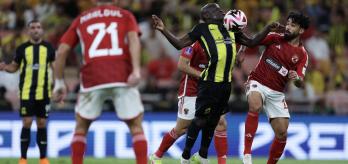When Al Ahly did not have the ball, they formed a 4-1-4-1 mid-block, with significant responsibilities for their defensive midfielder, Marwan Attia (13), and the two centre midfielders, Emam Ashour (22) and Ahmed Koka (36). These three were the lynchpin of the defensive structure, aggressively pressing and tracking Al Ittihad’s midfielders whenever they attempted to receive the ball.
Short team length
A notable feature of this defensive structure was its compactness. Al Ahly’s team length measured an average of 26m during the mid-block phase and 24.3m when in the low-block phase. Al Ittihad on the other hand measured in at 32.8m and 32.3m during these same periods of the game. When examining team length for mid-block and low-block phases combined, Al Ahly were on average 8m shorter than their opponents, further illustrating the compact nature of Egyptian side’s structure out of possession.
The reason this tactic was so effective is because Al Ahly completely negated the spaces where Al Ittihad’s talented and dangerous front three players wanted to operate. In their previous game against Auckland City, Karim Benzema (9), Igor Coronado (10) and Romarinho (90) were all effective and successful when operating between the midfield and defensive lines. However, against the Egyptian champions Al Ittihad were completely denied access to this area.
In addition, the aggressive and disciplined nature of the pressure and marking by Al Ahly’s midfielders on the hosts’ midfield trio of Fabinho (8), Ngolo Kanté (7) and Faisal Al Ghamdi (16) prevented Al Ittihad from progressing the ball centrally. Instead, attempted line-breaking passes became opportunities for Al Ahly to turnover possession and counter-attack quickly.
Applying pressure
Analysis of the match data shows Al Ahly initiated a forced turnover on 73 occasions, 23 more than Al Ittihad’s 50. In addition, all three of Al Ahly’s central midfielders were ranked in the top four for pressures applied during the match: Attia topped the chart with 39 pressures, Ashour ranked second with 33 and Koka came in fourth with 26.
According to Christian Gross, Al Ahly may have surprised the hosts with their approach, “everybody in the Middle East expected a thrilling game, but by dominating the central areas of the pitch and putting early pressure on their opponent’s midfield players, Al Ahly ensured that service to Al Ittihad’s forward players was very limited. Every time they tried to drop in between the lines to receive, they received intense pressure from Al Ahly’s defenders.
“Al Ahly were mentally ready and physically fresh and had great success making the pitch small when out of possession and could open space quickly when in transition to attack,” he added.
This observation is backed up by the match data. Despite Al Ittihad having a majority share of possession at 51.5% compared to Al Ahly’s 38.5% (10% in contest), the Egyptian side offered for the ball more frequently in behind, with 94 offers compared to the hosts’ 88. From these offers, the Al Ahly players successfully received the ball 10 times whereas the Al Ittihad players received on only four occasions. And, despite Al Ittihad being slightly more accurate with their overall distribution with an 83.4% pass completion rate compared to Al Ahly’s 81.7%, when we isolate penetrative line-breaking passes specifically, Al Ahly were much more efficient, completing 72.2% of their line-breaking passes compared to Al Ittihad’s 64.4%.
In the clips below we see how clearly defined Al Ahly’s roles and responsibilities were when they did not have the ball. Clip 1 shows the CAF champions operating in a mid-block with all three midfielders committed to staying central and cutting off passing lanes into Al Ittihad’s forward players. As the ball is played across the hosts’ backline, right forward Romarinho drops in deep to receive the ball, and despite how deep he goes, he is tracked diligently by Al Ahly left-back Ali Maâloul (21). Simultaneously, as Al Ittihad right-back Muhannad Al Shanqiti (13) positions high and very wide, Al Ahly’s left midfielder stays focused on him, remaining undistracted by Romarinho’s deep run. While these movements take place, Kanté attempts to occupy the space vacated by Al Ahly’s left-back but defensive midfielder Attia covers this while fellow midfielder Koka steps across to screen any attempted pass into Kanté. This is good example of the communication, organisation and the execution of role responsibilities by Al Ahly when out of possession.
In clip 2, we see another great example of the communication and rotations of Al Ahly’s midfielders as Al Ittihad probe to find spaces for line-breaking passes through their team shape. Again, their defenders show their appetite to track in deep to get strong pressure on the ball, as can be seen when left-centre-back Mohamed Abdelmonem (24) goes in tight against Benzema as soon as he attempts to receive between the midfield and defensive line.
Finally, in clip 3 we see an example of Al Ahly’s high pressure tactic as they aggressively press Al Ittihad’s build-up from a goal kick. Again, we see how Al Ahly’s midfielders lock on to man-mark and track their opponent’s midfielders while their defenders take responsibility for the host team’s forwards, even when they drop in very deep.











